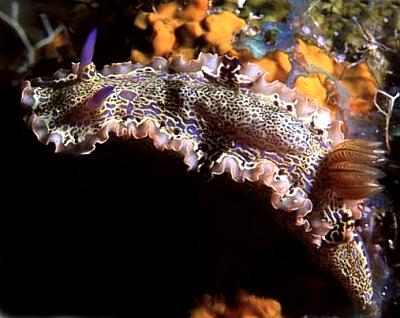
Hypselodoris acriba
Marcus & Marcus, 1967
Order: NUDIBRANCHIA
Suborder: DORIDINA
Superfamily: EUDORIDOIDEA
Family: Chromodorididae
DISTRIBUTION
Caribbean
PHOTO
On wreck of "The Aquila" on Roatan, Honduras, approx 85 feet.60 mm long. Photo: Dave Behrens.
The body is blue, covered with a fine yellow-gold mesh pattern. The rhinophores are brilliant purple-blue and the gills are gold. A wide marginal band of white to pink follows the highly ruffled mantle margin. The very edge of the mantle has a thin yellow followed by red line. A series of irregular black spots occurs along the inner edge of the ruffled margin. The yellow mesh network occurs over the tail and hyponotum.
Like so many of the Marcus' scientific names, no one seems to know the derivation of the name acriba.
Reference:
• Marcus, Er. & Marcus, Ev. (1967) American opisthobranch mollusks. Part 1, Tropical American opisthobranchs. Studies in Tropical Oceanography, Miami, 6(1-2): 1-137. (Figs 1-150, Pl.1, figs 1-9).
Behrens, D.W., 2000 (October 23) Hypselodoris acriba Marcus & Marcus, 1967. [In] Sea Slug Forum. Australian Museum, Sydney. Available from http://www.seaslugforum.net/find/hypsacri
Related messages
Hypselodoris acriba from Anguilla, BWI (Caribbean)
June 2, 2010
From: Tim Kary
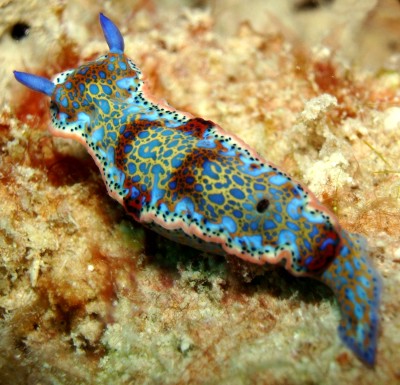
After reviewing pictures in Paul Humann's book and from this forum I have not been able to find a representation of this specimen although it appears to be some form of Hypselodoris.
The pictures show the specimen on a piece of coral rubble. Because of the bright blue coloration it was easy to spot on the white background. Note the opening where you would typically see the branchial plume. It changed diameter from the first picture (small opening) to the second picture (larger opening). The time lag between the two photos was approximately 10-15 seconds. Does the branchial plume retract?
Locality: Anguillita, 30 feet, Anguilla, British West Indies, Caribbean, 16 May 2010, hard pan and sand bottom, coral ledge. Length: 1.5 inches (4 cm). Photographer: Tim Kary.
Assistance on a species identification would be helpful.
Regards,
Tim Kary
tkary@earthlink.net
Kary, T. W., 2010 (Jun 2) Hypselodoris acriba from Anguilla, BWI (Caribbean). [Message in] Sea Slug Forum. Australian Museum, Sydney. Available from http://www.seaslugforum.net/find/23670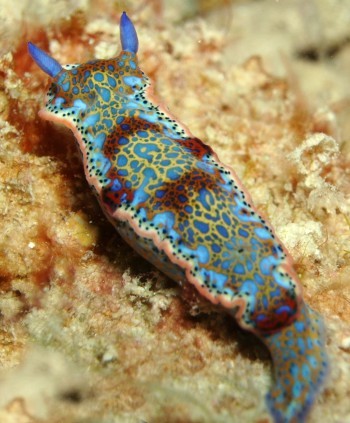
Dear Tim,
It is indeed a species of Hypselodoris and my guess is that it is Hypselodoris acriba. The blue markings, dark brown patches and pinkish border all seem to be consistent with other animals we have identified as that species. It seems the width of the white submarginal band around the mantle border is variable as is the amount of folding present in the mantle skirt. I suspect the identity of some of these colour 'varieties' will only be sorted out by local observers who can see numerous living specimens. That is the only way to make judgements on whether degrees of folding of the mantle skirt and similar colour variations merge one one state to another as you would expect if they were intraspecific variations. I guess molecular sampling could do it, but only if all specimens sampled were carefully photographed so we knew just which colour 'forms' had been sampled.
Best wishes,
Bill Rudman
Hypselodoris acriba from Biscayne National Park, Florida
May 4, 2005
From: Paul Osmond
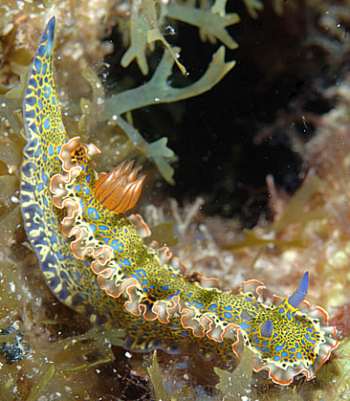
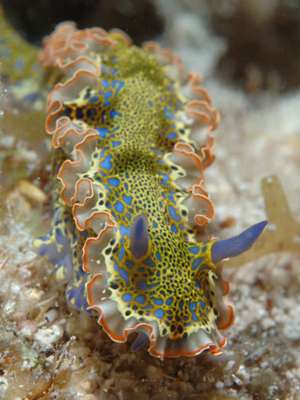
Bill,
Here is another sighting of Hypselodoris acriba from Florida and unlike my other message where a friend of mine saw it, this time I had the pleasure of seeing it for myself. This is one gorgeous nudibranch.
Biscayne National Park is about 40 miles from the previous sighting in Key Largo, Florida in 2003, so I think it is reasonably safe to assume there is an established population in the area - even if they are not seen often.
This one was moving over the remains of a late 1800's era wreck - and I mean really moving. For a nudibranch this one has quite a turn of speed and was very active. We had three photographers on the dive and it probably covered 10-15m in the 5-10 minutes we observed it (included a planned intentional float from the wreckage down to the ocean floor)
Locality: Earl Wreck, Biscyance National Park, Florida, USA, Atlantic. Depth: 5m. Length: 40 mm. 24 April 2005. Shallow ocean floor, natural wreck. Photographer: Paul Osmond
Enjoy,
Paul
marriard@deepseaimages.com
Osmond, P.T., 2005 (May 4) Hypselodoris acriba from Biscayne National Park, Florida. [Message in] Sea Slug Forum. Australian Museum, Sydney. Available from http://www.seaslugforum.net/find/13672Dear Paul,
Thanks for these great photos. Gradually we are beginning to clarify these Caribbean species of Marcus. It is becoming a real community exercise.
Best wishes,
Bill Rudman
Hypselodoris acriba from the Grenadines
August 21, 2003
From: Marli Wakeling
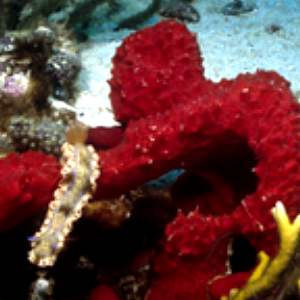
Hi Bill,
Here is Hypselodoris acriba that I found on a shallow dive in the Tobago Cays, near Carriacou in the Grenadines. Unfortunately, I had my 15mm lens on, so it's a tad small in the image. It's the first dorid that I have found in the Caribbean, but I guess it could be called on the fringe of the Atlantic. A gorgeous animal.
By the way, we also spotted a Hypselodoris bayeri in Grenada, but it was far too small (1 cm.)to show up on a wide angle shot.
Date: July, 2003
Dive Site: Snake Channel, Tobago Cays.
Depth: 35 feet
Length: 5 cm.
Photo: Marli Wakeling
Marli Wakeling
scubamarli@excite.com
Wakeling, M., 2003 (Aug 21) Hypselodoris acriba from the Grenadines. [Message in] Sea Slug Forum. Australian Museum, Sydney. Available from http://www.seaslugforum.net/find/10793Thanks Marli,
Considering the confusion surrounding the identity of some of these Caribbean chromodorids, I'll have to take your word on this ones identity, as its a bit hard to see enough detail to be sure.
Best wishes,
Bill Rudman
Hypselodoris acriba from Key Largo, Florida, USA
July 5, 2003
From: Paul Osmond
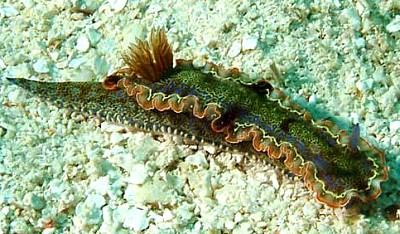
Hi there,
My friend John Easley found this nudibranch next to a shallow reef (about 20ft/6m) in Key Largo, Florida in the last week of June 2003.
It appears to be the basic shape of the other Hypselodoris species commonly known here as 'Sea Goddesses', but this is the first we have seen of this species in the area so we know absolutely nothing about it. It was not described in Humann which is still the best ID book currently available for Caribbean nudibranchs and I couldn't find it on this site either (but that may be because I am not sure what I am looking for)
John and I are both keen nudi hunters here and are attempting to learn as much as we can about the local species as there seems to be so little information in the Caribbean Would appreciate any thoughts and any identification.
Thanks,
Paul
Deep Sea Images
www.deepseaimages.com
deepsea@deepseaimages.com
Osmond, P., 2003 (Jul 5) Hypselodoris acriba from Key Largo, Florida, USA. [Message in] Sea Slug Forum. Australian Museum, Sydney. Available from http://www.seaslugforum.net/find/10378Dear Paul,
This is Hypselodoris acriba. It matches the Marcuses' description very well and looks very similar to Dave Behren's photo from Honduras. There aren't many records of this species. It was originally reported from off the Venezualan coast, there is the record from Honduras, and now there is yours from Florida.
Concerning your interest in learning more about these animals, we are definitely still in 'self-help' mode. We know very little about the Caribbean opisthobranch fauna - so every photo and message sent to the Forum helps us to all learn a bit more. Messages already posted on the Forum have taught us a lot of about the colour variation, and aspects of natural history [feeding, egg ribbons, etc]. At this stage almost any photo would help increase our knowledge of the Caribbean fauna.
Rudman, W.B., 2003 (Jul 5). Comment on Hypselodoris acriba from Key Largo, Florida, USA by Paul Osmond. [Message in] Sea Slug Forum. Australian Museum, Sydney. Available from http://www.seaslugforum.net/find/10378Hypselodoris acriba from the Caribbean
October 24, 2000
From: Dave Behrens

Bill:
Since several chromodorids from the eastern Pacific and Caribbean have been added to the Forum lately, may I add Hypselodoris acriba Marcus & Marcus, 1967. This specimen was collected on wreck "The Aquila" on Roatan, Honduras, in about 85 feet of water. The specimen was 60 mm in length.
The body is blue, covered with a fine yellow-gold mesh pattern. The rhinophores are brilliant purple-blue and the gills are gold. A wide marginal band of white to pink follows the highly ruffled mantle margin. The
very edge of the mantle has a thin yellow followed by red line. A series of irregular black spots occurs along the inner edge of the ruffled margin. The yellow mesh network occurs over the tail and hyponotum.
Like so many of the Marcus' scientific names, no one seems to know the derivation of the name acriba.
Dave Behrens
Dave@seachallengers.com
Behrens, D., 2000 (Oct 24) Hypselodoris acriba from the Caribbean. [Message in] Sea Slug Forum. Australian Museum, Sydney. Available from http://www.seaslugforum.net/find/3224Thanks Dave,
Bill Rudman.
